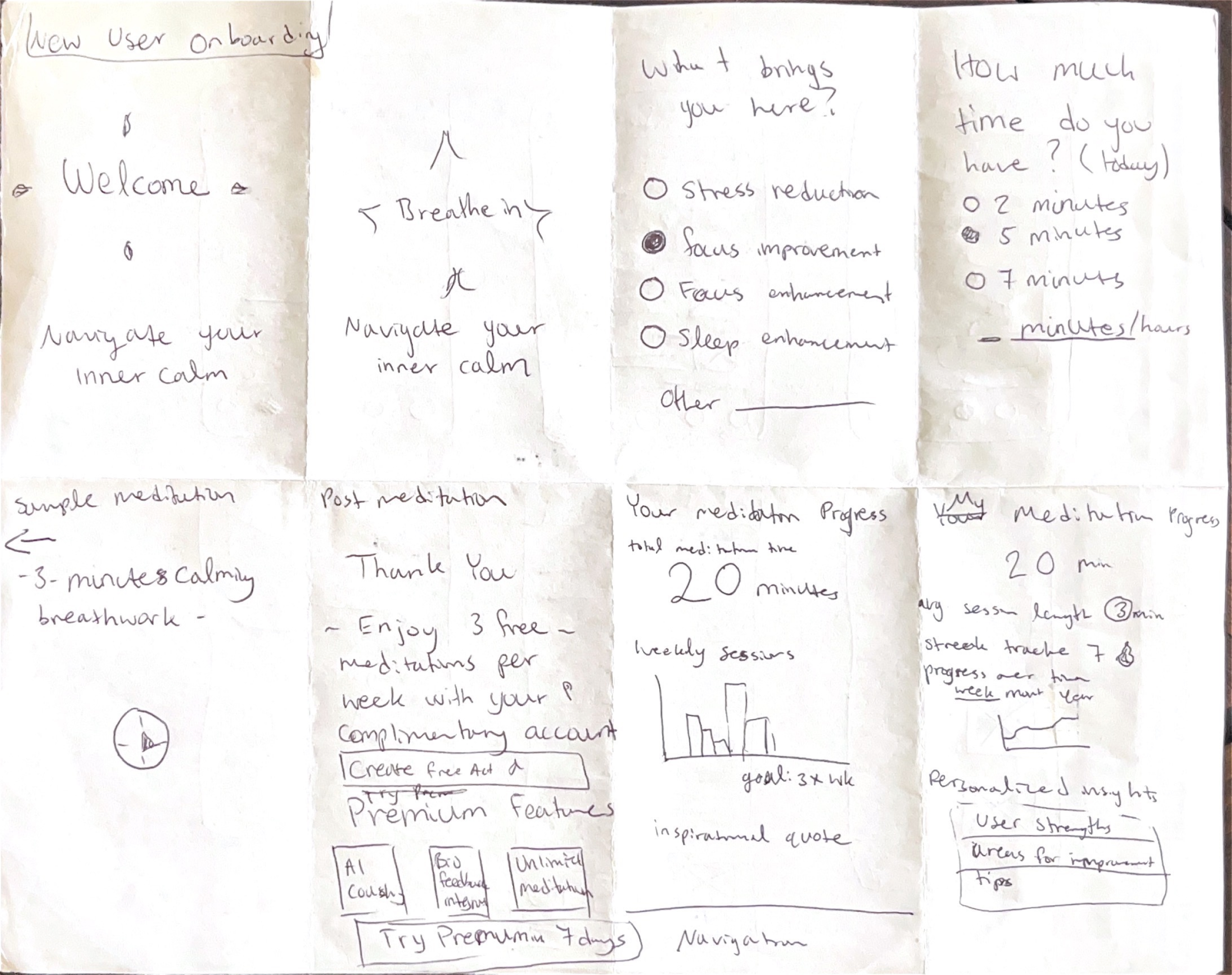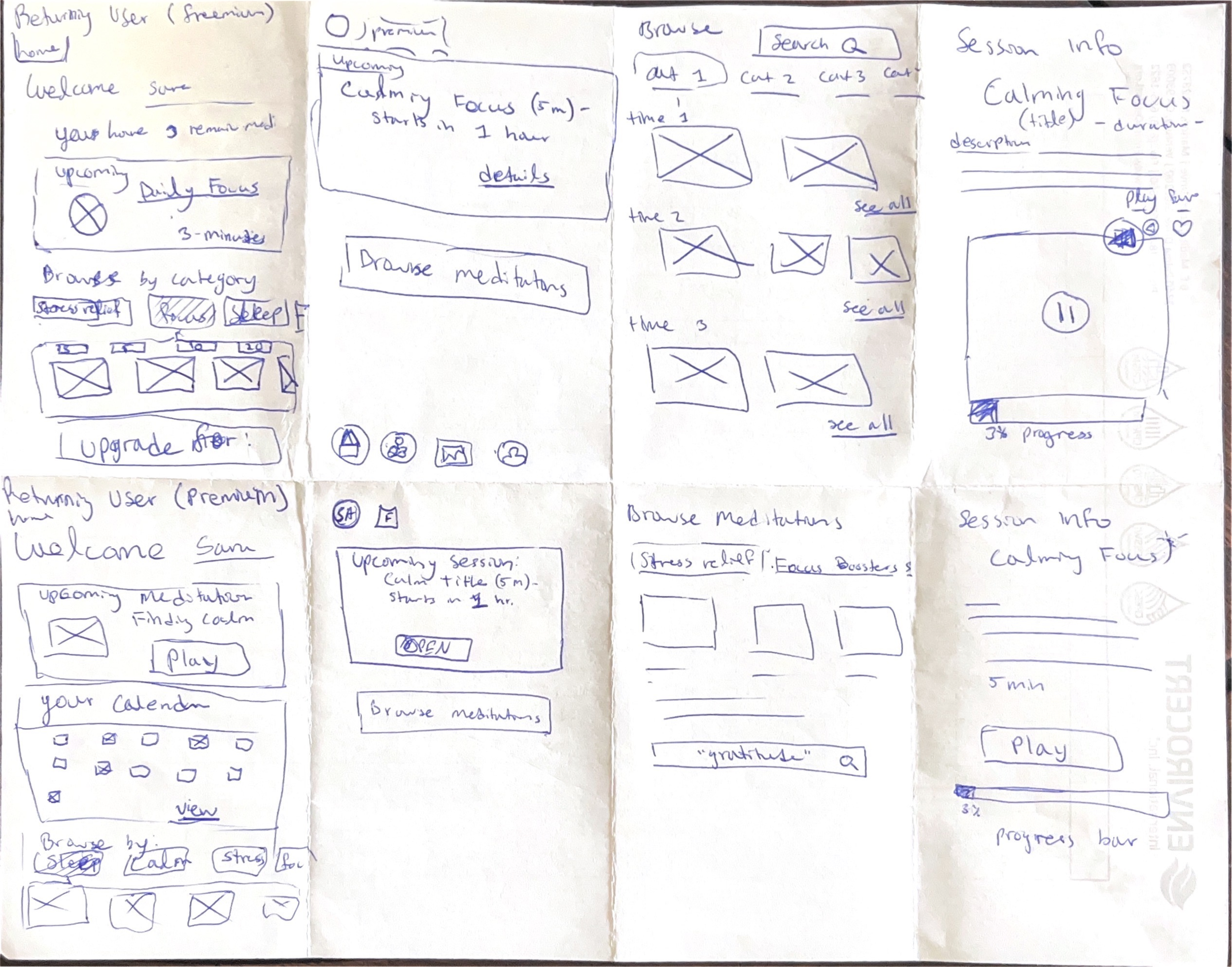Designing an Oasis of Calm: UX/UI for Inner Compass, Reaching 75% of Anxious US Population
UX Design • UI Design • Information Architecture
I leveraged user research to inform a 2-week design sprint, transforming Inner Compass into a user-friendly meditation app for busy professionals. The result? A calming, accessible haven that empowers users to find inner peace amidst the chaos. By prioritizing a streamlined and personalized onboarding process, I ensured the app seamlessly integrates into daily routines.
Timeline
2 weeks
April - May 2024
My Role
UX/UI Designer
Collaborators
UX Researcher
Product Manager
Developer
Deliverables
Ideation
User Work Flow
Mid-Fi Wireframes
Mockups
Prototype
Laying the Groundwork: Understanding the User Landscape
Building on the Foundation of Research: This UX/UI design case study builds upon the valuable insights gleaned from the earlier research phase of the Inner Compass project. Recapping key findings, users expressed a desire for a meditation app that offered:
Personalization: Cater to individual goals, time constraints, and meditation experience levels.
Seamless Integration: Integrate seamlessly into busy schedules.
Thematic Content: Offer guided meditations focused on specific themes like stress reduction or sleep improvement.
Accessibility: Prioritize inclusive design practices for users with diverse needs.
Charting the Course: Defining the Design Process
1
2
3
4
Define the Minimum Viable Product (MVP): Identify the core functionalities essential for the initial launch of Inner Compass, ensuring it delivers value to users while minimizing development time and resources.
Craft a Seamless User Onboarding Journey: Design a user flow for a smooth and personalized onboarding experience, guiding new users through the app's features and functionalities in a clear and intuitive manner.
Collaboratively Build the App Foundation: Through an iterative design process, including paper wireframes, low-fidelity wireframes, and high-fidelity prototypes, collaborate with my team and potential users to identify key features, refine the information architecture (IA), and ensure the app caters to user needs and expectations.
Envision Future Expansion: Develop a vision for future app development, exploring possibilities like biofeedback integration, fostering a community of users, offering live streamed meditation sessions, and leveraging advanced AI technology to further personalize the user experience.
Building the Core: Identifying Essential Features
Impact vs Effort
Based on the impact vs. effort matrix, a meditation app focusing on short, guided practices emerged as the most strategic MVP solution. Here's why:
High Impact: Meditation is a well-established practice known to effectively reduce stress, enhance focus, and improve overall well-being. Inner Compass directly addresses the core needs of the target audience.
Low Effort: Developing a core meditation app with pre-recorded guided meditations requires less technical complexity compared to other options like wearable biofeedback integration or sleep tracking features with extensive sleep cycle analysis.
Sparking Creativity: Generating Design Concepts
The design process began with two "Crazy 8's" sessions, a rapid ideation technique where we sketched eight unique design concepts (per session) within a short timeframe. This session proved invaluable in identifying elements that best aligned with Inner Compass's project goals. For example, one concept explored an onboarding question asking users about their preferred meditation duration (short bursts, longer sessions). This aligned with our goal of personalization, allowing the app to recommend meditations that fit seamlessly into users' busy schedules.
Guiding the Journey: Designing a Seamless First Impression
I decided to focus on a streamlined new user onboarding flow as competitors often have overwhelming new user onboarding processes.
The onboarding process prioritizes user experience with a concise set of three questions. Users can also add optional notes for further personalization. Based on their responses, the app recommends sample meditations, allowing them to dive right in and begin their meditation journey immediately.
Sketching the Vision: Bringing Ideas to Life
Designing for User Needs:
Keeping these user needs at the forefront, we implemented the following design solutions:
Personalized Onboarding Process: An onboarding process tailors the app experience based on user goals (stress reduction, focus enhancement, etc.), meditation experience (beginner, intermediate, advanced), and preferred time commitment (short sessions, daily practice, etc.).
Thematic Meditation Playlists: Curated playlists of meditations cater to specific user needs, allowing for focused practice sessions targeted at sleep improvement, stress reduction, or focus enhancement.
Intuitive Navigation: A clear and consistent navigation bar at the bottom of the screen provides easy access to all app sections (Meditation Themes, Progress Tracking, Settings).
Information Architecture: Content is organized logically, with categories like "Meditation Themes," "Progress Tracking," and "Settings" clearly labeled for easy exploration.
Transforming Sketches into Reality: High-Fidelity Designs
A Visually Tranquil Experience:
Visual design played a crucial role in promoting a sense of well-being within the app:
Calming Color Palette: A muted color scheme with soft blues, greens, and lavenders evokes feelings of calmness and serenity.
Nature-Inspired Imagery: Backgrounds and illustrations throughout the app feature soothing natural elements like rolling hills, calming oceans, and peaceful forests.
Material 3 Design Principles: Material 3 design principles were leveraged to create clean layouts, intuitive interactions, and a focus on content, minimizing cognitive load for users seeking a calming experience.
The Digital Experience: Creating an Interactive Prototype
Beyond the Horizon: Envisioning Inner Compass' Growth
Discover the Research Journey of Inner Compass
Witness the Design Transformation of Insurgent Business Analytics













